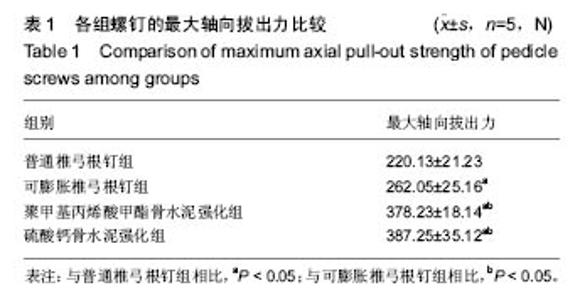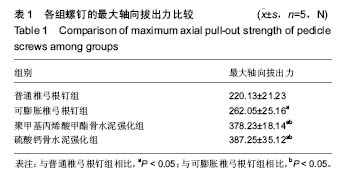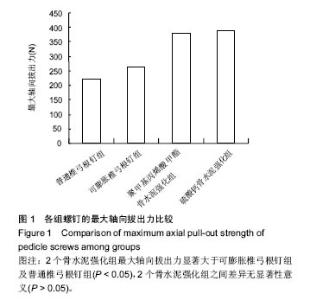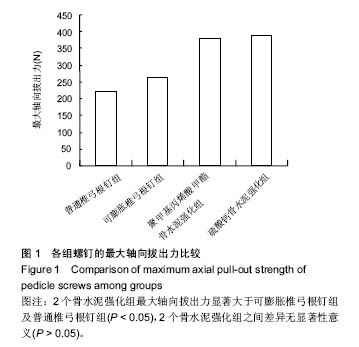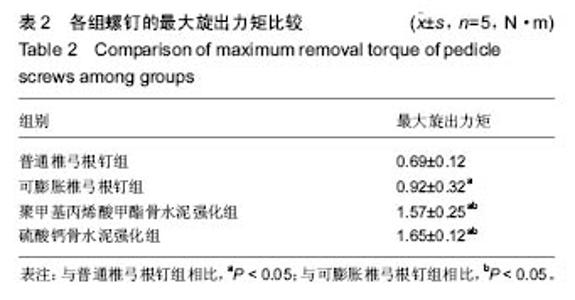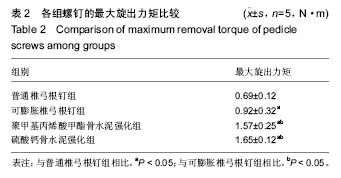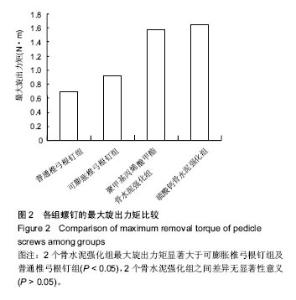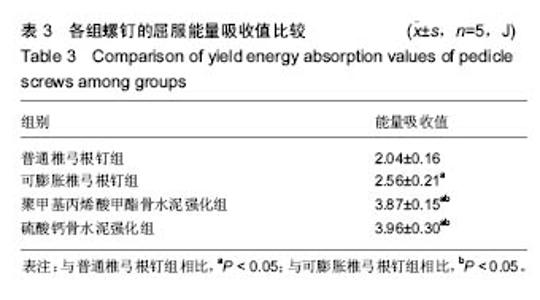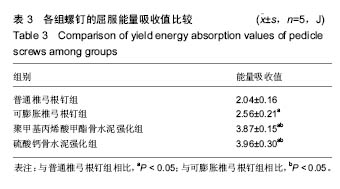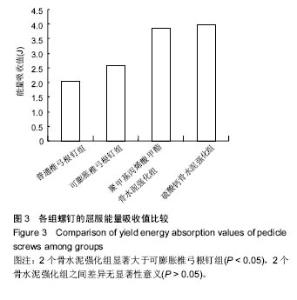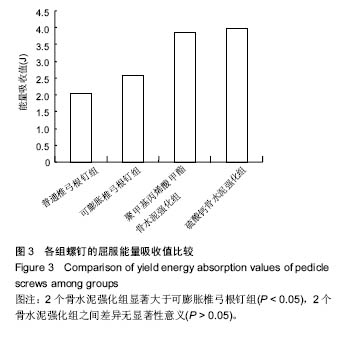Chinese Journal of Tissue Engineering Research ›› 2017, Vol. 21 ›› Issue (10): 1477-1482.doi: 10.3969/j.issn.2095-4344.2017.10.001
Effect of expandable pedicle screw fixation on the fixation strength of osteoporotic thoracic and lumbar vertebrae
Zhou Qing-zhong1, Feng Xiao-lan2, Zhang Ge3, Jia Xu-feng4, Lei Fei1, Ye Fei1, Feng Da-xiong1
- 1 Department of Spinal Surgery, 2 Department of Imaging, Affiliated Hospital of Southwest Medical University, Luzhou 645600, Sichuan Province, China; 3 Department of Orthopedics, Luzhou People’s Hospital, Luzhou 646000, Sichuan Province, China; 4 People’s Hospital of Jianyang City, Jianyang 641600, Sichuan Province, China
-
Received:2017-02-18Online:2017-04-08Published:2017-05-08 -
Contact:Feng Da-xiong, M.D., Chief physician, Department of Spinal Surgery, Affiliated Hospital of Southwest Medical University, Luzhou 645600, Sichuan Province, China -
About author:Zhou Qing-zhong, Master, Physician, Department of Spinal Surgery, Affiliated Hospital of Southwest Medical University, Luzhou 645600, Sichuan Province, China -
Supported by:the Scientific Research Project of the Affiliated Hospital of Southwest Medical University, No. 15073; the Scientific Research Project of the Southwest Medical University, No. 2015-YJ021; the Science and Technology Plan of Luzhou City, No. 2016-R-70(18/24); the Scientific Research Project of Sichuan Provincial Health and Family Planning Commission, No. 2016PJ552
CLC Number:
Cite this article
Zhou Qing-zhong, Feng Xiao-lan, Zhang Ge, Jia Xu-feng, Lei Fei, Ye Fei, Feng Da-xiong. Effect of expandable pedicle screw fixation on the fixation strength of osteoporotic thoracic and lumbar vertebrae[J]. Chinese Journal of Tissue Engineering Research, 2017, 21(10): 1477-1482.
share this article
| [1]Shea TM, Doulgeris JJ, Gonzalez-Blohm SA, et al. Balancing rigidity and safety of pedicle screw fixation via a novel expansion mechanism in a severely osteoporotic model. Biomed Res Int. 2015;2015:318405.[2]Liu D, Zhang Y, Zhang B, et al. Comparison of expansive pedicle screw and polymethylmethacrylate-augmented pedicle screw in osteoporotic sheep lumbar vertebrae: biomechanical and interfacial evaluations. PLoS One. 2013;8(9):e74827.[3]Liu D, Zhang Y, Lei W, et al. Comparison of 2 kinds of pedicle screws in primary spinal instrumentation: biomechanical and interfacial evaluations in sheep vertebrae in vitro. J Spinal Disord Tech. 2014;27(2):E72-80.[4]Idowu OE, Adewole OA, Majekodunmi AA. Posterior spinal decompression, stabilization and arthrodesis in Nigerian adults: Profile and outcome. Niger Med J. 2012;53(1):42-46. [5]Tai CL, Tsai TT, Lai PL, et al. A Biomechanical Comparison of Expansive Pedicle Screws for Severe Osteoporosis: The Effects of Screw Design and Cement Augmentation. PLoS One. 2015;10(12):e0146294.[6]朱如森.不同强化椎弓根钉内固定方法在骨质疏松腰椎退行性疾患中的应用比较研究[D]. 天津:天津医科大学,2013.[7]朱爱国,张烽,曹涌,等. 硫酸钙骨水泥增强椎弓根螺钉的生物力学分析[J]. 江苏医药,2015,41(12):1448-1449.[8]易早元. 经伤椎椎弓根植骨结合膨胀型椎弓根钉固定治疗老年性胸腰椎骨折[J]. 实用临床医药杂志,2014,18(19):124-126.[9]杨彬奎. 骨水泥强化对老年性腰椎骨折患者腰椎椎弓根钉固定的影响[D].西安:第四军医大学,2008.[10]Singh K, Smucker JD, Gill S, et al. Use of recombinant human bone morphogenetic protein-2 as an adjunct in posterolateral lumbar spine fusion: a prospective CT-scan analysis at one and two years. J Spinal Disord Tech. 2006;19(6):416-423.[11]雷伟,吴子祥,李明全,等. 膨胀式脊柱椎弓根螺钉固钉的生物力学研究[J]. 中国脊柱脊髓杂志,2004,14(11):669-672.[12]Reinhold M, Schwieger K, Goldhahn J, et al. Influence of screw positioning in a new anterior spine fixator on implant loosening in osteoporotic vertebrae. Spine (Phila Pa 1976). 2006;31(4):406-413.[13]Ramaswamy R, Evans S, Kosashvili Y. Holding power of variable pitch screws in osteoporotic, osteopenic and normal bone: are all screws created equal. Injury. 2010;41(2): 179-183.[14]Wu ZX, Gao MX, Sang HX, et al. Surgical treatment of osteoporotic thoracolumbar compressive fractures with open vertebral cement augmentation of expandable pedicle screw fixation: a biomechanical study and a 2-year follow-up of 20 patients. J Surg Res. 2012;173(1):91-98.[15]Wan SY, Lei W, Wu ZX, et al. Micro-CT evaluation and histological analysis of screw-bone interface of expansive pedicle screw in osteoporotic sheep. Chin J Traumatol. 2008; 11(2):72-77.[16]Cook SD, Salkeld SL, Whitecloud TS 3rd, et al. Biomechanical evaluation and preliminary clinical experience with an expansive pedicle screw design. J Spinal Disord. 2000;13(3):230-236.[17]Gao M, Li X, Zhen P, et al. Biomechanical study on effects of bone mineral density on fixation strength of expansive pedicle screw. Zhongguo Xiu Fu Chong Jian Wai Ke Za Zhi. 2013; 27(8):969-973.[18]Gao M, Lei W, Wu Z, et al. Biomechanical evaluation of fixation strength of conventional and expansive pedicle screws with or without calcium based cement augmentation. Clin Biomech (Bristol, Avon). 2011;26(3):238-244.[19]桑宏勋,吴子祥,雷伟,等.新型可膨胀椎弓根螺钉在骨质疏松性腰椎融合与固定手术中的初步应用[J].中华骨科杂志, 2009,29(9): 822-826.[20]赵利涛,郭明柯,秦耀宗.微创经皮附加伤椎椎弓根螺钉内固定治疗30例胸腰椎骨折的临床疗效评价[J].实用临床医药杂志,2013, 17(17):29-31.[21]费宝国.椎弓根钉棒系统在胸腰椎骨折治疗中的疗效分析[J].实用临床医药杂志,2013,17(14):104-106.[22]窦以宝,罗学勤.经伤椎椎弓根植骨结合膨胀型椎弓根钉固定治疗老年性胸腰椎骨折[J].脊柱外科杂志,2013,11(3):129-132.[23]Wan SY, Lei W, Wu ZX, et al. Micro-CT evaluation and histological analysis of screw-bone interface of expansile pedicle screw in osteoporotic sheep. Zhonghua Wai Ke Za Zhi. 2007;45(18):1271-1273.[24]Lei W, Wu Z. Biomechanical evaluation of an expansive pedicle screw in calf vertebrae. Eur Spine J. 2006;15(3): 321-326.[25]Lei W, Wu ZX. Biomechanical evaluation of an expansive pedicle screw in calf vertebrae. Chin J Traumatol. 2005;8(1): 39-45.[26]Nishikawa M, Ohata K, Baba M, et al. Chiari I malformation associated with ventral compression and instability: one-stage posterior decompression and fusion with a new instrumentation technique. Neurosurgery. 2004;54(6): 1430-1434.[27]Bostan B, Esenkaya I, Gunes T, et al. A biomechanical comparison of polymethylmethacrylate-reinforced and expansive pedicle screws in pedicle-screw revisions. Acta Orthop Traumatol Turc. 2009;43(3):272-276.[28]刘达,康夏,郑伟,等.骨质疏松绵羊腰椎膨胀式椎弓根螺钉与骨水泥强化椎弓根螺钉固定稳定性的动态比较研究[J].中国脊柱脊髓杂志,2014,24(8):747-751.[29]Zhang L, Sun Y, Jiang C, et al. Dorsal open reduction with pedicle screw rod internal fixation for lower cervical spine dislocation: A retrospective analysis of 12 cases. Neurochirurgie. 2016;62(5):245-250.[30]Liu D, Shi L, Lei W, et al. Biomechanical Comparison of Expansive Pedicle Screw and Polymethylmethacrylate-augmented Pedicle Screw in Osteoporotic Synthetic Bone in Primary Implantation: An Experimental Study. Clin Spine Surg. 2016;29(7):E351-357.[31]Yeh KT, Lee RP, Chen IH, et al. Laminoplasty instead of laminectomy as a decompression method in posterior instrumented fusion for degenerative cervical kyphosis with stenosis. J Orthop Surg Res. 2015;10:138. [32]Sun BF, Dong Y, Lü JY, et al. Expansive pedicle screws fixation combined with Wright artificial bone implantation for treatment of thoracolumbar burst fracture of the elderly patients. Zhongguo Gu Shang. 2011;24(7):544-546.[33]Liu D, Wu ZX, Pan XM, et al. Biomechanical comparison of different techniques in primary spinal surgery in osteoporotic cadaveric lumbar vertebrae: expansive pedicle screw versus polymethylmethacrylate-augmented pedicle screw. Arch Orthop Trauma Surg. 2011;131(9):1227-1232. [34]Gao M, Lei W, Wu Z, et al. Biomechanical evaluation of fixation strength of conventional and expansive pedicle screws with or without calcium based cement augmentation. Clin Biomech (Bristol, Avon). 2011;26(3):238-244.[35]Wan SY, Lei W, Wu ZX, et al. Micro-CT evaluation and histological analysis of screw-bone interface of expansive pedicle screw in osteoporotic sheep. Chin J Traumatol. 2008;11(2):72-77. |
| [1] | Yao Xiaoling, Peng Jiancheng, Xu Yuerong, Yang Zhidong, Zhang Shuncong. Variable-angle zero-notch anterior interbody fusion system in the treatment of cervical spondylotic myelopathy: 30-month follow-up [J]. Chinese Journal of Tissue Engineering Research, 2022, 26(9): 1377-1382. |
| [2] | Jiang Huanchang, Zhang Zhaofei, Liang De, Jiang Xiaobing, Yang Xiaodong, Liu Zhixiang. Comparison of advantages between unilateral multidirectional curved and straight vertebroplasty in the treatment of thoracolumbar osteoporotic vertebral compression fracture [J]. Chinese Journal of Tissue Engineering Research, 2022, 26(9): 1407-1411. |
| [3] | Zhu Chan, Han Xuke, Yao Chengjiao, Zhou Qian, Zhang Qiang, Chen Qiu. Human salivary components and osteoporosis/osteopenia [J]. Chinese Journal of Tissue Engineering Research, 2022, 26(9): 1439-1444. |
| [4] | Li Wei, Zhu Hanmin, Wang Xin, Gao Xue, Cui Jing, Liu Yuxin, Huang Shuming. Effect of Zuogui Wan on bone morphogenetic protein 2 signaling pathway in ovariectomized osteoporosis mice [J]. Chinese Journal of Tissue Engineering Research, 2022, 26(8): 1173-1179. |
| [5] | Xiao Hao, Liu Jing, Zhou Jun. Research progress of pulsed electromagnetic field in the treatment of postmenopausal osteoporosis [J]. Chinese Journal of Tissue Engineering Research, 2022, 26(8): 1266-1271. |
| [6] | Gao Yujin, Peng Shuanglin, Ma Zhichao, Lu Shi, Cao Huayue, Wang Lang, Xiao Jingang. Osteogenic ability of adipose stem cells in diabetic osteoporosis mice [J]. Chinese Journal of Tissue Engineering Research, 2022, 26(7): 999-1004. |
| [7] | An Weizheng, He Xiao, Ren Shuai, Liu Jianyu. Potential of muscle-derived stem cells in peripheral nerve regeneration [J]. Chinese Journal of Tissue Engineering Research, 2022, 26(7): 1130-1136. |
| [8] | Zhang Jinglin, Leng Min, Zhu Boheng, Wang Hong. Mechanism and application of stem cell-derived exosomes in promoting diabetic wound healing [J]. Chinese Journal of Tissue Engineering Research, 2022, 26(7): 1113-1118. |
| [9] | Peng Kun. Improvement of the treatment effect of osteoporotic fractures: research status and strategy analysis [J]. Chinese Journal of Tissue Engineering Research, 2022, 26(6): 980-984. |
| [10] | Song Jiawei, Yang Yongdong, Yu Xing, Yang Jizhou, Wang Fengxian, Qu Yi, Bi Lianyong. Mid-term effect of Isobar EVO non-fusion dynamic fixation in the treatment of adjacent segment disease after lumbar fusion [J]. Chinese Journal of Tissue Engineering Research, 2022, 26(6): 908-913. |
| [11] | Chen Xiaoxu, Luo Yaxin, Bi Haoran, Yang Kun. Preparation and application of acellular scaffold in tissue engineering and regenerative medicine [J]. Chinese Journal of Tissue Engineering Research, 2022, 26(4): 591-596. |
| [12] | Kang Kunlong, Wang Xintao. Research hotspot of biological scaffold materials promoting osteogenic differentiation of bone marrow mesenchymal stem cells [J]. Chinese Journal of Tissue Engineering Research, 2022, 26(4): 597-603. |
| [13] | Shen Jiahua, Fu Yong. Application of graphene-based nanomaterials in stem cells [J]. Chinese Journal of Tissue Engineering Research, 2022, 26(4): 604-609. |
| [14] | Zhang Tong, Cai Jinchi, Yuan Zhifa, Zhao Haiyan, Han Xingwen, Wang Wenji. Hyaluronic acid-based composite hydrogel in cartilage injury caused by osteoarthritis: application and mechanism [J]. Chinese Journal of Tissue Engineering Research, 2022, 26(4): 617-625. |
| [15] | Li Hui, Chen Lianglong. Application and characteristics of bone graft materials in the treatment of spinal tuberculosis [J]. Chinese Journal of Tissue Engineering Research, 2022, 26(4): 626-630. |
| Viewed | ||||||
|
Full text |
|
|||||
|
Abstract |
|
|||||
